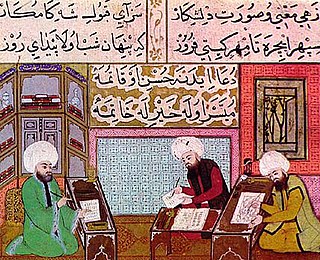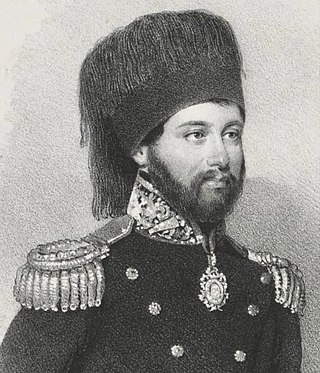
Tahsin Aykutalp (1926 - 16 December 2013) was a Turkish miniature artist and teacher of tezhip.
Contents
He is recorded as saying "There is a miniature technique in all my cells". [1]

Tahsin Aykutalp (1926 - 16 December 2013) was a Turkish miniature artist and teacher of tezhip.
He is recorded as saying "There is a miniature technique in all my cells". [1]
Dündar Tahsin Aykutalp was born in Istanbul in 1926 to his father Hayri Bey and mother Mevhibe Hanım, who was from the Kayi Tribe. His grandfather was Nakkaş Mevlüt Ağa. He gets his name Dündar from one of the generals of Fatih Sultan Mehmed who was named Dündar Bey. His early childhood was spent in the Silivrikapı district of Fatih where he also completed his primary education at a primary school named Yirmidördüncü İlkokulu. He attended middleschool at Mevlanakapı Ortaokulu. At this school his art teacher Sa'im Bey noticed Aykutalps talents in drawing and upon Sa'im Beys suggestion Aykutalp does the entry exam for the State Fine Arts Academy. Of the 400 participants of this exam he achieves the first place and is accepted to the Fina Arts Academy in 1946. Although being technically two months too old, upon the encouragement of some of the teachers he enters the Traditional Turkish Arts department. At the academy he is educated inder Cevat Dereli, Mustafa Halim Özyazıcı, Necmeddin Okyay, Feyzullah Dayıgil, İsmail Yümnî and Beykozlu Hüseyin Hoca. He graduated in 1951. [2]
After his graduation he commences his mandatory military service. He serves 6 months in Ankara and 6 more months in Siirt as an officer. He marries Saadet Hanım in 1956 and produces one female and one male offspring with her. The decide to name their son, the male offspring, İsmet; their daughter, the female offspring is named Hayri. [2]
Aykutalp starts his career working for the Istanbul Municipality for six and a half years. In 1960 he is invited by the Iraqi Government to teach at an institute affiliated with Baghdad University. He teaches there for another six and a half years, teaching tezhip, çini and carpet lessons, until the 1967 Arab-Israeli war. Upon his return to Turkey he teaches for some time at the Fatih Boys College and Ahmet Rasim Middleschool. [2]
For the 1975-76 academic year he is appointed as a tezhip teacher at the Mimar Sinan Academy of Fine Arts, Traditional Turkish Arts Department. Here he becomes one of the founders of the Traditional Turkish Handicrafts Department along with teachers such as Neşe Aybey, Nezihe Bilgetay and İslam Seçen. He teaches in his field, tezhip, until 1993 the year which he retires. After that he continued to teach for some time as a part-timer. [2]
In 1999 he got a severe sickness and stopped working as a teacher at the university. [3]
He died 16 December 2013 and his body was lifted in the funerary procession from the Fatih Mosque, Istanbul and buried in İstanbul-Eyüp at the Eyüp Sultan Graveyard. [3]

Mustafa Fazıl Pasha was an Ottoman-Egyptian prince of ethnic Albanian descent belonging to the Muhammad Ali Dynasty founded by his grandfather Muhammad Ali Pasha.

Ottoman miniature or Turkish miniature was a Turkish art form in the Ottoman Empire, which can be linked to the Persian miniature tradition, as well as strong Chinese artistic influences. It was a part of the Ottoman book arts, together with illumination, calligraphy, marbling paper, and bookbinding. The words taswir or nakish were used to define the art of miniature painting in Ottoman Turkish. The studios the artists worked in were called Nakkashanes.

Turkish art refers to all works of visual art originating from the geographical area of what is present day Turkey since the arrival of the Turks in the Middle Ages. Turkey also was the home of much significant art produced by earlier cultures, including the Hittites, Ancient Greeks, and Byzantines. Ottoman art is therefore the dominant element of Turkish art before the 20th century, although the Seljuks and other earlier Turks also contributed. The 16th and 17th centuries are generally recognized as the finest period for art in the Ottoman Empire, much of it associated with the huge Imperial court. In particular the long reign of Suleiman the Magnificent from 1520 to 1566 brought a combination, rare in any ruling dynasty, of political and military success with strong encouragement of the arts.

Peyveste Hanım was a consort of Sultan Abdul Hamid II of the Ottoman Empire.

Turkish or Ottoman illumination covers non-figurative painted or drawn decorative art in books or on sheets in muraqqa or albums, as opposed to the figurative images of the Ottoman miniature. In Turkish it is called “tezhip”, meaning “ornamenting with gold”. It was a part of the Ottoman Book Arts together with the Ottoman miniature (taswir), calligraphy (hat), bookbinding (cilt) and paper marbling (ebru). In the Ottoman Empire, illuminated and illustrated manuscripts were commissioned by the Sultan or the administrators of the court. In Topkapi Palace, these manuscripts were created by the artists working in Nakkashane, the atelier of the miniature and illumination artists. Both religious and non-religious books could be illuminated. Also sheets for albums levha consisted of illuminated calligraphy (hat) of tughra, religious texts, verses from poems or proverbs, and purely decorative drawings.

Şehzade Mehmed Selaheddin Efendi was an Ottoman prince, the only survived son of Sultan Murad V, and his second consort Reftarıdil Kadın.

Yervant Voskan was an Armenian painter, sculptor, instructor, and administrator. He is the first known sculptor in modern Turkish sculpture history and as the first sculpture teacher at the Sanay-i Nefise he educated the first generation of Turkish sculptors.
Resan Hanım was a consort of Sultan Murad V of the Ottoman Empire.
Saliha Sultan was an Ottoman princess, the daughter of Sultan Mahmud II and Aşubcan Kadın. She was the half-sister of Sultans Abdulmejid I and Abdulaziz.

Damat Gürcü Halil Rifat Pasha, was an Ottoman admiral and statesman of Georgian origin. He served in the periods of Mahmud II and Abdulmejid I.
Hatice Aynışah Sultan was an Ottoman princess, daughter of Sultan Bayezid II and sister of Sultan Selim I of the Ottoman Empire.
Emine Naciye Sultan was an Ottoman princess, called also Naciye Enver, the daughter of Şehzade Selim Süleyman, son of Sultan Abdulmejid I.
Mihrimah Sultan was an Ottoman princess, the daughter of Sultan Mahmud II, and his consort Hoşyar Kadın. She was the half-sister of Sultans Abdulmejid I and Abdulaziz.

Şehzade Abdurrahim Hayri Efendi was an Ottoman prince, son of Sultan Abdul Hamid II and Peyveste Hanım.

Şehzade Ibrahim Tevfik Efendi was an Ottoman prince, the son of Şehzade Mehmed Burhaneddin, and grandson of Sultan Abdulmejid I.

Hayriye Hanımsultan was an Ottoman princess, the daughter of Adile Sultan and Damat Mehmed Ali Pasha.
Selma Hanımsultan was an Ottoman princess, the daughter of Rauf Hayri Bey and Hatice Sultan.
Nursen Güven is a Turkish artist. She is Turkeys first and only female muralist. Her husband is Güvenç Güven, one of the most important representatives of İznik Çini. She teaches at Haliç Çini Merkezi and Ayvansaray Eğitim Birimi. In 1995 she and her husband opened their own workshop.
Alev Demirkesen, is a Turkish artist who works in the field of Turkish decorative arts. Her works include ceramic decoration, miniature and illumination.
Mesude Hülya Şanes Doğru is a Turkish master craftsman, ceramic decorator and academic, trained in the art of miniature.